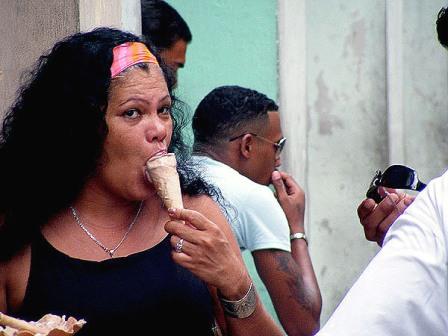What You Can Buy with One, Three or Ten
Regina Cano
 A plantain costs three pesos from a cuenta propista (an official term meaning a “self-employed worker”).
A plantain costs three pesos from a cuenta propista (an official term meaning a “self-employed worker”).
Three pesos is the cost of each sausage in the form of a hot dog but with the flavor of chicken —when there is any— from a State-run bodega store.
It costs three pesos for a round cupcake filled with guava, which are sold “on the side” (meaning without authorization) by street vendors.
A batido (a milk shake) goes for three pesos, the same as a papaya, mammee or a mango sold at a private cafeteria, the only places where these are sold.
Three pesos is also what is charged for a loaf of soft bread, whose weight varies according to the bakery that produces it and the neighborhood in which that operation is located.
For 3.50 pesos you can buy a sandwich with a thin slice of ham or jamonada (ham ground with other additives), according to the State regulated price.
Three pesos are what the price of lemons have been lately.
But one peso will get you a plastic bag from most street vendors, which compares to half a peso from a State salesperson. These are free for bagging up your purchases in an official market that sells in hard currency CUCs, though sometimes you have to insist on one.
A peso is what many passengers give to bus drivers to drop them at a location different from the regular bus stop in exchange for their favor.
The same is charged by any bus driver going in any direction, whether the vehicles belongs to their workplace or is an authorized back-up bus for normal routes.
With 1.00 peso they’ll give you two cigarettes on the informal smokers’ market, but with .05 pesos more you can buy three from the State.
And, you can drink coffee for the same one peso price.
A roll costs 1.00 peso on the informal (black) market, while they charge 0.05 pesos for the same biscuit in the same bakery when buying through your ration book – though you only get one roll daily per person.
For 1.50 pesos you can pick up an egg outside the rationing system (authorized by the Ministry of Domestic Trade) and for 2 pesos when they’re resold on the black market.
For the price of one peso you can drink a glass of kool-aid in any one of the existing markets.
A peso is the price of a tortica (a type of cookie), without it mattering who sells it to you.
A peso pays for a durofrio (homemade popsicle), and its typical customers are children.
This is also the price of a cucurucho de mani (a thin paper cone containing peanuts), as well as a frozzen (a machine made ice cream in a cone) or a granizado (a flavored cup of crushed ice).
The price of rice has risen to 10 pesos a pound on the black market; it costs 3.50 pesos at the unregulated state price (outside of the rationed price system).
Ten pesos is the cheapest price for Cubans to ride in a private taxi, with fixed routes inside the capital city.
More than ten pesos is what they charge you for a pound of beans.
And for this same price you can get what one would doubt are the best pizzas in the capital.
In the peso market —where a great part of peoples’ wages are spent (be it through authorized channels or on the black market)— this is a short inventory of certain daily expenses purchased in regular national currency, because that of hard currency, called CUCs, is another thing.






This is a lesson for extravagant colonizers..Also most grocers in america carry the Cuban cafe..i live in Fla and i buy it for my staff in bulk from a Cuban grocer which are plentiful in this state ..But krogers Sweet bay albertson and Walmart carry it
I’d like to get my hands on some of that coffee! Anyone know where it is sold outside Cuba?
And one peso for a glass of guarapo (cane juice). Delicious!
The author was talking about drinking a shot of coffee on the street not buying ground coffee.
Forgot about the coffee. Was 10 on the black market, now 15 for a half pound, clear plastic bag. Or with the shortage of cafe, is it more in some places.